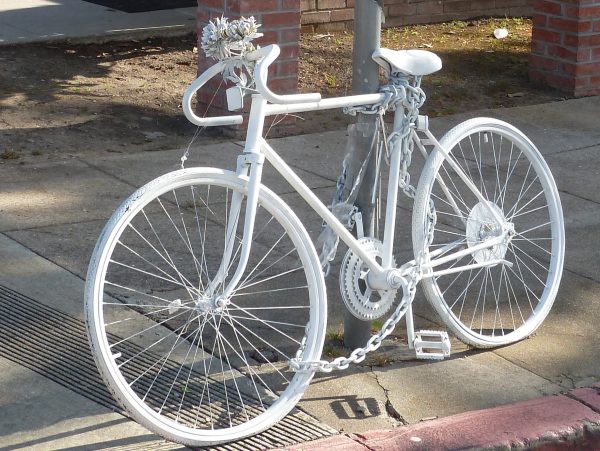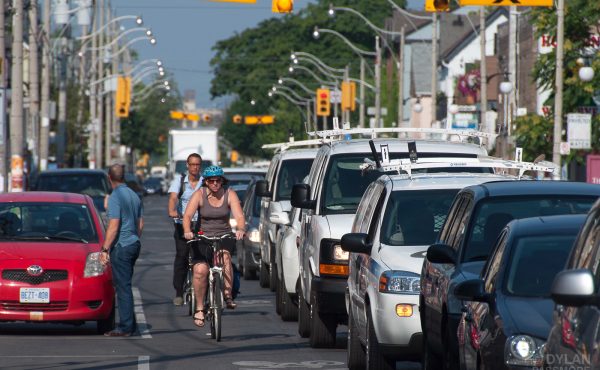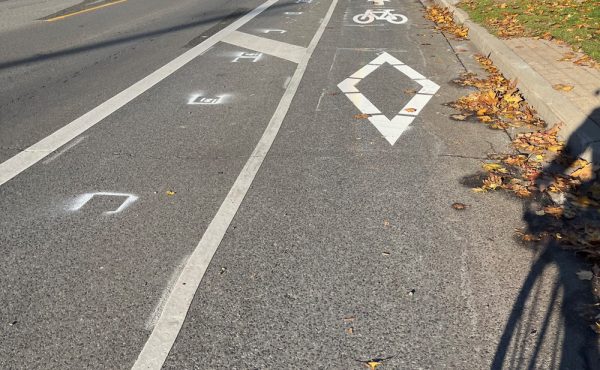EDITOR’S NOTE
Spacing is inviting candidates who are running for city council this fall to share their opinions on numerous city-building topics. Articles are not an endorsement from Spacing — we hope to create a space for intelligent and informed conversations about the challenges faced by Toronto.
Sarah Climenhaga is a mayoral candidate. Follow her on twitter at @SarahforMayorTO
With the recent announcement of $22 million in Vision Zero funding, it’s worth considering the high price Toronto pays for a road system designed around cars. We are averaging the loss of one life every week. As of June 13 — exactly two years following the City’s announcement of the Vision Zero plan to eliminate traffic fatalities — 93 people had been killed on Toronto’s roads.
Nor has designing our city this way made things easy for motorists, as anyone who has sat in rush hour congestion will attest. As people seek alternatives to being stuck in traffic or overcrowded transit, they are turning to active transportation. The cost of that choice for too many has been death or serious injury. Will these new expenditures be enough to turn the tide?
First, we must recognize three things.
- The right to safety on our public roads is greater than the right to unimpeded traffic flow.
- The number of deaths and serious injuries is not the only measure of road safety; near misses and minor collisions are also important. Currently, a person on foot is hit by a person in a car at least every three hours.
- As Toronto’s density increases, the number of people switching choosing non-driving modes of transportation will grow. So too will the frequency of collisions unless we take action.
Much of our Vision Zero action so far has been to post signs (that are ignored); launch educational campaigns (that are ineffective); or conduct occasional enforcement blitzes (which don’t result in permanent behavioural change).
Instead, we need to use evidence of what works to reduce both the speed and the volume of motor traffic, and address the driving behaviours that make crossing the street a death-defying prospect. Lowered city speed limits is a proven part of the solution, as is banning right turns on red. Increased enforcement and cameras are important in the short term, though these are costly solutions that penalize drivers rather than change driving conditions. There will be less need for such measures once road design has improved.
Design changes must include putting speed humps or other traffic calming measures in all school zones in the next four years. Such changes will make the streets safer for those currently on foot, as well as those who wish they could allow their children to walk to school on their own but are too afraid of current road conditions to do so.
Creating wide, accessible sidewalks will allow people with mobility challenges to participate fully in public life, not be isolated or dependent on help to navigate their own neighbourhoods. Where sidewalks are lacking, we must add safe infrastructure so that people are not forced into close proximity to large speeding vehicles. In areas where people regularly cross the street on a dangerous stretch of roadway, a safe crossing must be put in place. Admonishing people for jay-walking (though mid-block crossings are perfectly legal), or urging seniors to walk half a kilometre out of their way to cross the street to their TTC stop is unrealistic and unfair.
Then there is the relatively simple matter of traffic signals. Timing is often too short for people to get across the street, and intervals between crossings can be so long that people risk crossing on a red light. When we accept that safety is of paramount importance, the need to change signal timing to favour pedestrians becomes clear. In places with high volumes of foot traffic, pedestrian scrambles — where people can cross diagonally if they wish — are a safe, friendly option.
To lower traffic volume, we must make other options attractive for those who wish to get out of their cars and free up space on our congested roads. Too often the need for bike infrastructure is disputed. Cyclists are depicted as a small group of hard-core advocates — categorized in a Portland study as “strong and fearless” — who will ride (and get in the way of drivers, seen as the rightful owners of our public streets) no matter what. This disregards the lives of people who now cycle and neglects the many “interested but concerned” people who would like to ride but are simply too afraid. A minimum grid of fully protected bicycle corridors across our entire city would attract those potential riders, presenting a great opportunity to reduce congestion at a fraction of the cost of expensive road infrastructure. Connecting routes within and between neighbourhoods will enable more choice for more people of how to get around in their communities.
Finally, we need to integrate safety, choice and accessibility in all decisions around transportation. If we do that, decisions such as the one around whether to narrow Yonge Street north of Sheppard and south of Finch will be far less contentious. Transforming that corridor into a pedestrian and cycle friendly Main Street, lined with businesses and safe for neighbouring residents, while still including four vehicle lanes, should be approved without any further delay.
While council’s decision to increase funding is a welcome sign that calls for action are being heard, it is still woefully inadequate compared to what is needed to make our streets truly safe. We have no problem spending billions on an unproven subway stop, or rebuilding an obsolete expressway, yet we are still spending a pittance on safety compared to jurisdictions like New York City that have effectively lowered their traffic death rates. Until we commit to a meaningful increase in spending on measures already proven to be effective, and until we adopt transportation policies — like Transform Yonge — that reallocate space from cars to people on foot or two wheels, we are only paying lip service to the issue, and will continue to see unnecessary loss of life.
Ultimately, along with saving hundreds of people from the grief and suffering that comes with tragic occurrences on our roads, Toronto will experience many gains as we transform from an auto-oriented city to a people-oriented one. Even those who drive will be better off — Netherlands, a country long associated with a safe and widespread active transportation culture, was rated in the Waze survey as the best place in the world to drive in. When our streets are designed with people in mind, our population will be more mobile, healthier, and happier, while our city will be more equitable and accessible. We have nothing to lose, and everything to gain.





4 comments
One of the reasons for increased danger to cars is pent up frustration for drivers who sit in long lineups as one or two cars make it through a light that doesn’t have an advanced green for a left turn and heavy pedestrian traffic on a right turn. And since going straight thru is blocked by that vehicle turning right only a few cars make it through each green light cycle. It is human nature that given their one chance to get through the intersection, a motorist will ‘hit the gas’. Add to that a pedestrian or a cyclist deciding they can make it through a yellow light turning red and you’ve got a recipe for disaster. No lower speed limit is going to help that. I say (for example) give Harbord to bikes exclusively and ban then entirely from Bloor.
From Cars not to cars (previous comment)
FOUR E’s
Education; Motorists, cyclists, pedestrians.
Enforcement: Traffic wardens and police.
Everywhere; Streets, Bike paths, Sidewalks.
Everyone; Motorists, cyclists, pedestrians.
Mayor Tory and his suburban majority are fundamentally incapable of being anything but carrupt, carservative, and carist. While the Fords lowered the bar for safety and respect for non-car citizenry, the dismal (and dismale) actions on transit and tax equity (each car apparently gets $2700 a year in avoided costs via Globe of 1997 see vtpi.org ), Mayor Tory had choices that would be fairer to those in the core, like the VRT. Also inequitable/bad is the PWIC, where up until just recently, the core was shut out. (Even now, Ms. McMahon isn’t really so ‘core’ as all that, but she gets these issues and speaks up for safety and equity). The priorities are to spend big billions and use a lot of concrete: it’s not to provide that good transit in the core that can take some political will sometimes (King RoW something, yes, but inferior in 1993 WWLRT EA analysis vs other transit).
We still lack continuity on bike lanes, and safety’s on a ward-by-ward basis eg. the Annex Bloor project, which didn’t go east to that bit of Bloor St. E. in the 2001 Bike Plan, where a tiny sum (compared to the budget) could repaint the road between Sherbourne and Church to provide bike safety. That now has to be a stop-gap measure of simpler wider curb lanes, if we want something this year, since oh, repaving pushed back till??? It is so stupid that we cannot manage to have continuity of bikeway relief for our stretched Danforth and Bloor subway, despite the 1992 report saying it was the best place for an east-west bike route and no streetcar tracks to stop cheap/easy lane-line repaintings. Progressives haven’t gone to bat for us here either, not really, so I think it’s fair to say Jack would be ashamed/angered given that it’s 2018 and the climate crisis and subway crisis/overload is very very real.
The rot is also at the TTC beyond the SSE: even though the Council (often Clowncil) said no extension north of Yonge till there’s relief, the TTC is blithely approving tunnel and station design because there’s federal funding making it ‘free’, and once the design is done, will there be resistance, or just ‘it’s designed, so if you want any $$$$$ for any transit project in the core, you HAVE to accept this extension”, but no push for regional fixes for regional transit, like GO (and why not?) or other new-ish ideas like surface transitways core-to-Eglinton. Better transit is needed for safety too, not just climate.
Ms. Climenhaga didn’t explore a vital aspect of road safety though – the enforcement or lack of it. I know at times it’s hard to discern what happened in a crash, and it’s more difficult when one of the best witnesses isn’t alive to tell her or his side of it, and sometimes, we do less-wise things. But I don’t think there’s been much in the way of charges against drivers who’ve killed cyclists thus far; and that’s not feeling right. I include Daryl Craig, killed on Dec. 21 on College St., somehow, but no charges, and did the tracks have something to do with it all? (The TTC doesn’t want to hear about how streetscar tracks harm cyclists – bikes are the competition, and the core subsidizes suburbs).
While Mr. Tory has a real work ethic, presents very well, and does seem to care, overall, the track record is ‘desulTory’ – and change is needed, including many of the Councillors.